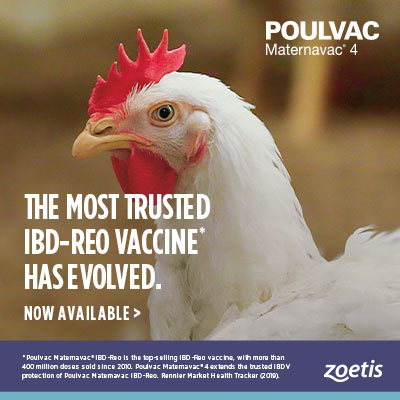Catching problems in layer vaccination — and making them right
An interview with Andy McRee, DVM, senior technical services veterinarian, Zoetis
Q: When it comes to vaccinating layer flocks, are there any obvious signs that something isn’t going quite right in the vaccination procedure?
AM: When we first go into a house to assess vaccination, we like to get there after the crew has had time to vaccinate a number of birds. You can tell a lot about what’s going on from sitting back and observing; if it’s really dusty, very loud or the vaccinators’ movements are erratic, the vaccination procedure is probably poorly organized or being hastily completed. We want to see birds being vaccinated in a calm, organized manner.
Q: What are the most serious challenges vaccinator crews encounter?
AM: The biggest challenge is getting injections into the proper place, which requires paying attention to details. The breast muscle, for instance, is easy to access, but in young birds it’s thin. If you get down too low you can go through the muscle and into the abdomen. That can cause some heavy reactions — to the point of killing the bird. If you’re injecting subcutaneously into the back of the neck, you must avoid the neck musculature and certainly avoid the spinal cord.
Q: How can vaccinators avoid injecting into the wrong place?
AM: The environment for vaccinating needs to be well lit so vaccinators can easily see where they’re injecting. Needle guards on the end of injectors can help prevent the needle from going too deep. But proper handling is even more important.
Q: How should birds be handled during vaccination?
AM: The vaccinator needs to have easy access to the target. I’ve seen vaccination crews grab as many birds as they can and flop them on the table; then they have to sort through a mass of feathers to find their target. I like to see birds vaccinated individually. A lot of people think this method is going to take longer, but it’s actually quicker because the vaccinator can more readily find the target location.
Q: Do you have any advice for using a manual, single- or double-needle injection gun?
AM: With single-needle guns, two different products come into a manifold and then out into one needle. You have to make sure the calibration on both barrels is equal and the appropriate amount of vaccine is coming from each barrel. This type of injection gun is easier to use because there’s just one needle and one target. However, a lot of guns have two barrels and two needles. That works great to vaccinate on either side of the bird if the needles are positioned over the keel appropriately. But I too often see birds poorly positioned. If they’re on their side, one needle goes into the breast, but the other can go into the thoracic inlet or into the keel itself. You’ve got to be very precise.
Q: What about automated, double-breast injection machines? Can they help ensure uniformity?
AM: Vaccinating a whole house of chickens can be a lengthy process. It’s easy to get distracted, lose your concentration or just get fatigued, which can lead to misapplication. That’s where the newer double-breast injection machines can help make vaccination procedures more efficient. It’s a lot easier to push a bird’s breast into a molded form with automatic triggering.
Q: Are there any other ways you’d recommend improving vaccination techniques?
AM: We have a procedure called the pullet vaccination evaluation, or PVE. It’s a detailed checklist covering everything from crew safety to vaccine preparation and storage. It’s vitally important because it gives us a chance to interact with customers and vaccination crews. We can provide tutorials, or if we see something that’s not going right, we work with the crew to enhance their technique.
Q: How can vaccination success be evaluated?
AM: In the big commercial houses, we’ll assign areas to specific individuals on the vaccination team. Then we take a sampling of birds from each section and test with serology. If that shows a good immune response with high antibody titers across all the birds, the individual who was assigned to that section vaccinated properly.
Q: Can bird-welfare considerations be a driver to improve vaccination procedures?
AM: Definitely. We’re learning a lot from bird-welfare standards in Europe. Birds are not going to perform well if they’re not handled properly, and that has to be incorporated into vaccination procedures. The goal is moving the birds in a way that causes minimal excitement. Calm birds can perform better, so the less we can stress them, the better they’ll respond to vaccines.
All trademarks are the property of Zoetis Services LLC or a related company or a licensor unless otherwise noted.
TOOLBOX, Issue 28
Toolbox is a series of interviews with veterinarians and other technical specialists about their experiences managing antimicrobials, vaccines and other tools for poultry health. It is produced by the editors of Poultry Health Today on behalf of the US Poultry Business of Zoetis.
NA-02732
Dec 2021
Posted on February 23, 2022
















